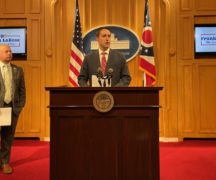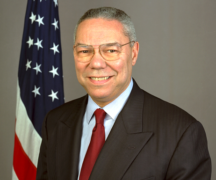BY NICK EVANS
Backers and opponents of Issue 1, the proposed Ohio constitutional amendment that would raise the bar for passing future amendments, squared off in a televised debate Tuesday night. Their arguments didn’t break new rhetorical ground, but the forum’s broad reach may encourage more voters to turn out.
Secretary of State Frank LaRose and Ohio Right to Life President Mike Gonidakis spoke in favor of Issue 1. Ohio House Minority Leader Allison Russo and former Columbus Dispatch editor and Democratic state lawmaker Mike Curtin spoke for opponents of the amendment.
Early vote figures from the Secretary of State’s office indicate the election is already on track for historic turnout in an August election. So far, public data only covers the first seven days of voting. But at least when it comes to in-person ballots, turnout is similar to last year’s mid-term general election.
The elephant in the room
Tuesday, LaRose announced organizers behind a different amendment have collected the necessary signatures to appear on November’s ballot. That proposal, which would enshrine protections for abortion access in the state constitution, is inextricably linked to Issue 1.
Despite protests to the contrary, lawmakers insisted on advancing Issue 1 and advancing it in August, to undermine the reproductive rights amendment. Some of Issue 1’s loudest supporters premise their argument on fighting abortion — to the chagrin of several other supportive groups.
Their involvement, however, was impossible to ignore with Gonidakis on stage speaking in favor of the amendment.
LaRose drew the connection explicitly, and underscored the spurious arguments offered by anti-abortion activists. He described the reproductive rights amendment as “the most extreme abortion amendment in the country that would take away parental rights and really subject children to potential child abuse without the parents even knowing that’s something to be afraid of.”
In an interview after the debate LaRose and Gonidakis stood by those claims. Independent fact checkers disagree, and a similar measure in Michigan didn’t undermine its parental consent statutes.
“Listen,” Russo said during the debate, “it’s hard to take seriously two people — one a politician, and one an anti-abortion lobbyist who supports a total abortion ban with no exceptions for rape or incest — to take anything that they say seriously about what a reproductive rights amendment actually does.”
An easy mark?
LaRose argued the state’s constitution isn’t the place for “policy making,” and defended putting the amendment forward on an August special election after previously lobbying to eliminate those elections.
Supporters’ core argument held that imposing a supermajority requirement would “protect” the constitution from out of state special interests.
“Special interest groups have figured out that Ohio is a relatively easy mark when it comes to amending our constitution,” LaRose said.
When pressed by the moderators neither side elaborated what share of issue campaign funding comes from out of state. Some national organizations count themselves among Issue 1’s opponents, but the most visible out-of-state special interest is backing the vote yes campaign.
Illinois billionaire Richard Uihlein has put more than a million dollars behind the effort. Nevertheless Gonidakis made the argument that a “yes” vote is the best way to discourage similar donors.
“We can take the for sale sign off our state constitution by voting yes on Issue 1 and raising the threshold,” Gonidakis argued, “because they’re going to fly over our state when they realize they can easily slip whatever they want in with $10, $15, $50 million.”
“That Illinois billionaire that you mentioned that bothers you?” he added, “Vote yes on Issue 1 because he’s not coming back to Ohio.”
Issue 1 does nothing to actually stop out-of-state donations. Instead, proponents’ argue that higher threshold would discourage amendments. As Russo noted in committee hearings, Florida, which has the same 60% threshold Issue 1 proposes, has actually seen the opposite.
Curtin meanwhile took aim at proponents’ argument that policy shouldn’t be set in the Constitution. “Secretary LaRose may not like it,” he said, “but it has always been a policy document.”
And Curtin went further, criticizing their comparison to the federal constitution which requires 2/3 of Congress and 3/4 of state legislatures.
“Anybody who tries to compare any state constitution to the U.S. Constitution flunks federalism 101, flunks constitutionalism 101,” Curtin said.
“Madison said it best when he said the powers reserved to the U.S. constitution will be few and defined, and the powers reserved to state constitutions will be numerous and indefinite,” he continued. “That’s because the Founders intended to leave all the details to the states.”
Speaking after the debate, Russo said LaRose might have a point about Ohio being an easy mark.
“I’ll tell you what has been an easy mark,” she said, “it’s been our legislature. That has been the easy mark. And again, here we are with Issue 1 punishing Ohio voters, not the legislature, where the corruption originates, where the influence of special interests originates.”
“And Issue 1 does nothing to tackle that easy mark,” she said.





